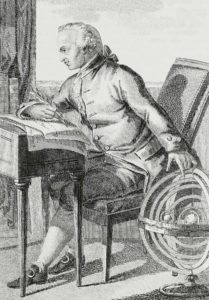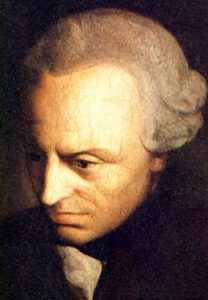Kant and Aesthetics
The Creation of Artistic Freedom and Art-for-Art’s Sake
France became the titular home of the Enlightenment because of the necessity of opposing the decadence of the ancien régime, but it must be recalled that there were numerous important philosophers in England as well—the Earl of Shaftesbury, John Locke, David Hume–who were operating in a more “enlightened” society where royal power had long since been effectively curbed. England had had its revolution, endured the rule of the middle class, the Puritans, and had gladly restored the monarchy in 1688. The English, wary of religious extremism, endured in Cromwell, established a careful balance of power between the Crown and the People and Religion.In the next century, while they were building their colonial empire, the British learned the hard way about the power of the people when the American colonies rebelled and fought their way to freedom, using the ideas of the Enlightenment that were developed in Europe. The American Revolution was a philosophical affair, a grand experiment in democracy. To the amazement and alarm of Europeans, the Americans were turning philosophical systems into a Constitution, a government, and a way of life. And yet, it was in what we can only call “the Germanies,” not yet a modern nation, but a collection of principalities, that philosophers synthesized Enlightenment philosophy and extended it to a world now called “modern.”

“Dare to reason—have the courage to use your own minds—is the motto of the Enlightenment.” This powerful statement, defining the Enlightenment, was written by Emmanuel Kant (1724 – 1804) in 1784 in Germany, a singularly un-Enlightened disunited land. In his essay, “What is Enlightenment?” Kant defined the Enlightenment briefly and cogently as the foundation of a new conception of the essential qualities of the state and of history. “History” exists as a concept, according to Kant, only in relation to a series of events moving towards an ideal unity or an immanent end. Writing belatedly at the end of the Enlightenment period, Kant coupled history with a teleological purpose. The question, for the Enlightenment philosopher, is that of the goals of history. The contemplators of past events–the historians–are no longer standing in the midst of a simple series of discrete events, but are philosophers observing a series of actions that include the idea of individual freedom. History was a process of self-liberation, a process from natural bondage towards a sense of individual becoming in a spiritual sense. Ending with a tribute to his ruler, Frederick the Great, Kant asked and answered a simple question:
If we are asked , “Do we now live in an enlightened age?” the answer is, “No,” but we do live in an age of enlightenment. As things now stand, much is lacking which prevents men from being, or easily becoming, capable of correctly using their own reason in religious matters with assurance and free from outside direction. But on the other hand, we have clear indications that the field has now been opened wherein men may freely dea1 with these things and that the obstacles to general enlightenment or the release from self-imposed tutelage are gradually being reduced. In this respect, this is the age of enlightenment, or the century of Frederick.
In place of irrational belief systems, the Enlightenment has created a doctrine of rational faith (perhaps a contradiction in terms)—faith in the powers of human reason. Kant has been called the First Modernist, probably because he was among the most significant late-Enlightenment philosophers. Kant sought to solve the problems put forward or suggested by the early Enlightenment philosophers and sought to establish an epistemology of knowledge based upon the deductive powers of human reason. He had to establish a system of modern morality and ethics for human behavior, without God, based upon “practical reason.” He had to establish a universal means of arriving at a judgment recognized universally as being valid. Ultimately, Kant had to create an architectural structure for the new individual in an Age of Enlightenment and to do that he wrote three foundational books upon which modern philosophy would rest and develop.
The Enlightenment is deeply concerned with politics: how people can rule and/or be ruled without God or King and the divine right of aristocracy. The issue of freedom must be balanced against morals and truths and social controls. Society and culture are in a state of change and flux and doubt under pressure from the rising aspirations of the lower classes and the growing power of the middle class. Enlightenment philosophy both witnesses these changes and seeks to contain an unprecedented social situation that upends prevailing traditions. Art is but one casualty of a culture, which goes into shock from experiencing modernity in the beginning of the Nineteenth Century. The old grounds for judging “art” as worthy of being “art” began to deteriorate. In more stable time, “art” had been that which the Church ordered, what the King demanded, or what the patron wanted, or what the Academy dictated. Thus “art”and its definition was based upon elements external to “art,”such as desire and interest. The ordering of art had worked for centuries but, in Kant’s time, that authoritarian class was in the process of being wiped out where the definite of “art” was formed–France. It was time to establish an epistemology for “art,” and in doing so, Kant was joining a small number of philosophers who were writing the new discourse called “aesthetics,” or the definition of art.

Engraving of Immanuel Kant at his Desk
One of the pioneer philosophers to contribute to the new discourse on aesthetics, Alexander Gottlieb Baumgarten (1714-1762) who coined the word “aesthetics,” which he drew from the Greek term, aisthanomai or perception, the conditions of sensuous perception, which was the same as the Latin word, sentio. Baurgarten realized that he was venturing into a new area of philosophy, that which engaged the senses in a fashion that was both physical and emotional (not based in reason) when the human engaged with art or reacted to nature. The results of such encounters were subjective, judgments that could not be grounded in the objective. As Baumgarten said, “Things known are to be known by the superior faculty as the object of logic; things perceived [are to be known by the inferior faculty, as the object] of the science of perception, or aesthetic.” Aesthetica (1750/1758) was written in Latin which perhaps accounts for the slow acceptance of the new word. In 1835 in Vorlesungen über die Ästhetik, Georg Hegel succinctly defined aesthetics and placed it firmly within philosophy: “..the real name of our science is the philosophy of art and more specically the philosophy of fine art..” By the end of the nineteenth century, aesthetics had entered into the common parlance, mainly because the ground for judging art, an oxymoron, had become more and more necessary over the century. Notice that with Kant and Hegel, the idea of aesthetics or a philosophy of art was limited to “fine art.” According to Lars-Olof Åhlberg, “..it is with D’Alembert’s introduction, the Discours préliminaire, to the Encyclopédie ou Dictionnaire Raisonné des sciences, des arts et des métiers (1751) that..the modern system of the arts (painting, sculpture, architecture, poetry, music) is set forth in its inal form.”
Thus Kant’s aesthetic philosophy became the right philosophy for the right time—his aesthetic ideas restored the order and purpose of art, ironically by injecting art with the disorder of originality and stripping it of all purpose but its own. Kantian aesthetics developed out of a sense of crisis in the arts, which were unanchored without traditional purpose or patronage, bereft of subject matter and content, once dictated, and validated by Church and State. Already, the artists in France had discovered the vagaries of the middle class public, the new audience to which they were subjected in public salons. Equally depressing was the rise of yet another new enemy, the art critic who freely gave his (unlearned) influential opinion of the endeavors of the artists. How should art be judged? Who had the right to judge? The jurors? The teachers? The artists? The critics? The patrons? or the public? The goal of Kant was to put judgment on a universal basis and, because art fell neatly into the realm of subjectivity, he used art as his model in his discussion of aesthetics for the role of judgment and how the human mind could reach universal judgments from a disinterested perspective. There is a disjuncture between perception and a resulting sensation and noesis or knowledge and the Enlightenment had pushed out the subjective and the impact of emotions or psychology upon human thinking. It is important to note that this dichotomy which Kant would attempt to solve in his last Critique was of less interest to his nineteenth century leaders than his new definitions of artist and art.

Emmanuel Kant
The Critique of Judgment was published in Prussia in 1790 and it established aesthetics as a new branch of philosophy. Kant based his third and final volume of his philosophical trio upon certain assumptions that we do not believe today but which, for him, were accepted as “true” to the point of blindness. For Kant, something called “art” existed and the grounds of art was beauty. Understanding art required judgment and the judgment, like those of reason and science, had to be, of necessity, universal. We as humans, possess the capacity to judge (Urteilskraft) and this power allows us to make individual judgments (Urteile). In many ways, one feels that Kant was compelled to take up the slippery area of judgment. In the Critique of Pure Reason (1781), he established the grounds of a priori reason within the architectonic structures of the human mind; in the Critique of Practical Reason (1788), Kant was able to define morality as that which exists simply as a value in itself, independent of and indifferent to any reward. One does good because it is good, now because one will receive approval for being moral. In both cases, judgment haunted the Critiques like an uninvited guest, refusing to leave and demanding to be dealt with. A judgment was defined by its subjective state and by its dire need to be placed on an objective basis–because we “judge” all the time. We judge science as being true or not, based upon empirical testing; we judge certain kinds of behavior as good, based upon the outcome. But how does one judge art and beauty? Kant was particularly concerned about the role of taste in judgment, that is, individual likes and dislikes—interests and desires, which had to be purged for any judgment to be valid.

Although Kant was concerned with beauty in art and with the operation of the (judging) mind when faced with the sublime, it is taste which must be tamed by critique. The issue is neatly summarized in the two necessary words: subjective and universal–taste is subjective but judgment has to be universal. It is one thing to be stirred by the awesome beauty of nature or being moved by nature’s more modest offerings, it is another operation to judge an objective made by a human being. When judging fine art, one operates with “taste” which is a response to beauty. Later, Marcel Duchamp will criticize mainstream art directly on this basis, that “taste” is a subjective and sensuous and physical reaction to a object that is stimulating to the retina. In order to forestall such a superficial reaction, Kant searched for the ends or the purpose of the object as well as the result of the work of the artist, which were, of course, intertwined. If the artist and the art were cause and effect, then the artist was manifested through the art. But what should the end of art be? Or to ask the question in another fashion, how could art be rescued from the blandishments of the client or from the personal feelings of the spectator? For Kant, purpose and intention (Absicht) seem to be co-extensive, meaning that he was obligated to investigate the artist as well as the grounds for art. If the artist was at the beck and call of a patron, then the intention of art was not art’s intention, begging the question, how could it be properly called “art” in the universal sense? The problem is clear–the purpose of art will be conditioned by the telos or end–the will of the patron, and that cannot stand.
If judgment is teleological, and it is, for Kant, then the beginning must rest within the artist and it is here that Kant began to solve his problem of purpose: the artist was a “genius,” a new concept which separated the “artist” from a maker or a copyist or from someone dutifully following orders. Obviously, the modern artist cannot live within an academy or and art school or be ruled by a jury. The modern artist is the creator who plays with forms in order to create new forms; the modern artist is an inventor, an innovator. These new concepts will be discussed in the next posts.
If you have found this material useful, please give credit to
Dr. Jeanne S. M. Willette and Art History Unstuffed. Thank you.